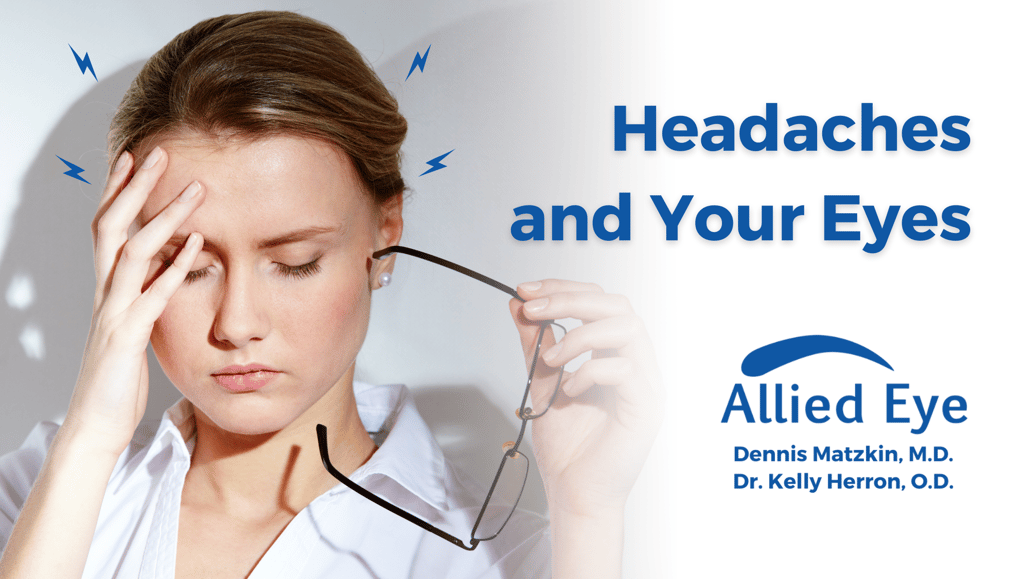Headaches: we’ve all had them. They can range from a mild annoyance to severe pain that can take you totally out of commission. In addition, headaches can be a sign of serious brain pathology and all chronic headaches should be evaluated by an ophthalmologist.
For the mild ones, we usually pop a few Tylenol or ibuprofen and keep going. With severe or regularly occurring headaches, we might seek relief by calling our primary care doctor but the truth is they are not trained to investigate or manage headaches, other than classical migraine. It is your ophthalmologist that is best to determine whether your headaches need more than an aspirin, or a migraine pill - whether you need a brain scan or see a neurologist.
Primary Headache Disorders
Migraine Headaches
Migraines are often accompanied by vision disturbances. Many sufferers report seeing visual auras before the headache even begins. Migraines can cause extreme sensitivity to light and intense pain behind one or both eyes.
Certain foods, bright lights, hormones, and exhaustion are some of the things that can trigger a migraine, but some people find them completely unpredictable. They’re also frequently accompanied by nausea and vomiting. Although migraine symptoms are often centered around the eyes, migraines aren’t an eye disorder. They are a neurobiological disorder, one scientist recently linked to certain cerebral structures becoming hyperactive and misfiring strong pain signals to the meninges (the membranous tissue between the brain and the skull.)
Cluster Headaches
Like migraines, cluster headaches are a neurobiological disorder that can cause piercing pain around and behind the eyes. Also called trigeminal autonomic cephalalgia, their symptoms may include swollen eyelids and watery, burning eyes.
Cluster headaches are severe and recurring and can make you feel extremely sensitive to light and sound. These headaches may classically cause you to get out of bed at night and pace up and down seeking relief.
Tension Headaches
Perhaps the most common type of headache, tension headaches are usually milder than clusters or migraines. They can also cause eye pressure and light sensitivity.
Chronic Eye Strain & Headaches
Eye strain is often blamed for headaches, but most headaches are caused by the primary headache disorders listed above. However, eye strain, especially staring at a screen for hours can lead to tension headaches. Eye strain symptoms include:
- Sore, dry or tired eyes
- Watery eyes
- Blurred vision
You probably can blame eye strain if your headaches only occur after you’ve spent a long time reading, using the computer or doing close work. Driving long distances, prolonged wind or sun exposure, and low light conditions can contribute to eye strain and associated headaches.
Eye strain may also be caused by uncorrected nearsightedness, farsightedness, or astigmatism. If you already have eyeglasses or contact lenses, frequent headaches can be a sign that it’s time for a new prescription.
Serious Headaches:
There is a condition called IIH or pseudotumor cerebri where the pressure in the brain is elevated causing headache, double vision, ringing in the ears, transient visual loss and even permanent visual loss. IIH usually occurs in young women who are often overweight, where excessive fluid surrounding the brain is unable to drain into the venous channels back to the heart.
The best specialist to make this diagnosis and arrange work-up and treatment is the ophthalmologist. The classical finding is swollen optic nerve and side vision loss. Brain scans and spinal tap to measure brain pressure will likely be ordered in such cases.
Other Eye Conditions Associated with Headaches:
These conditions can cause eye discomfort that reflects referred pain from a headache:
- Eye infection or inflammation
- Dry eyes
- Injuries or diseases of the cornea
- Giant cell arteritis (temporal arteritis)
- Acute angle-closure glaucoma
- Ocular ischemic syndrome
- Optic nerve conditions
Treatment Options:
Headache treatment options focus on reducing the frequency and severity of your pain. You can often figure out if eye strain is the culprit by eliminating the life factors that seem to contribute to your eye strain symptoms.
Over-the-counter painkillers can help, as well as resting in a dark, quiet room. Warm or cool compresses and neck or temple massages are other tried-and-true headache home remedies. Reducing stress, staying well hydrated, and getting enough rest and exercise can all play a part in reducing the frequency and severity of headaches.
If you suffer from migraine or cluster headaches, new treatment options are on the horizon. In March 2021, a group of scientists won the $1.5 million Brain Prize for their work in understanding primary headache disorders. A new type of injectable monoclonal antibody is showing promise in blocking a neuropeptide that appears to generate this type of severe headache pain.
If you recognize any of the signs and symptoms above, you probably wonder if your headaches are linked to your eyes. Call or text us today at (423) 855-8522 to see how we can help you get to the root of your pain. Our COVID-19 protocols are still in place because our staff is committed to keeping you safe!


